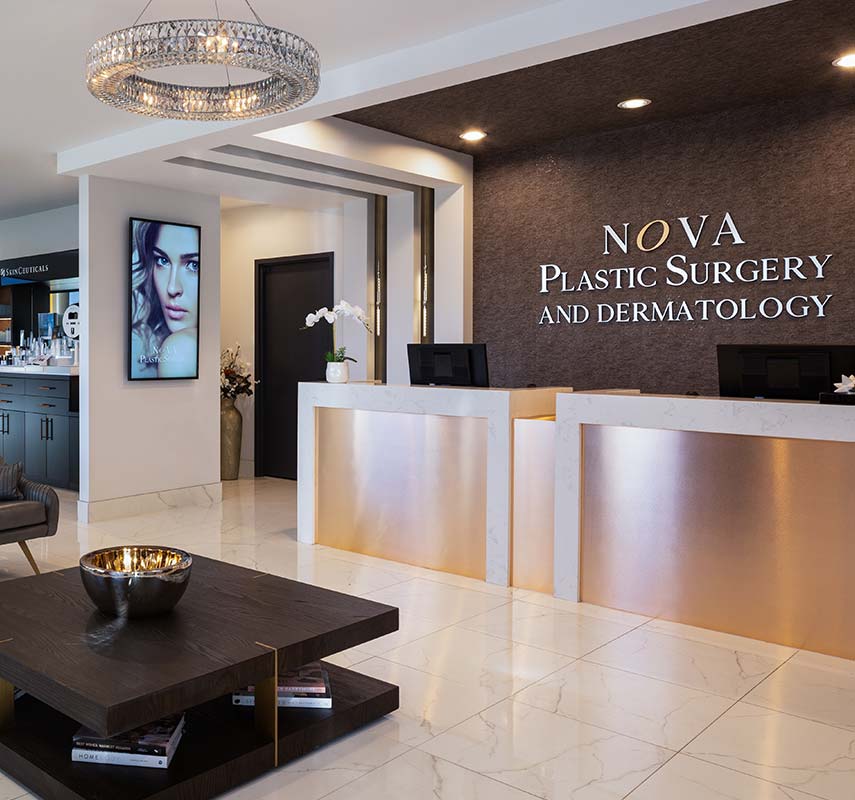

What is Breast Augmentation and Lift Surgery?
A breast augmentation and lift is a combination procedure wherein the patient undergoes a breast lift and gets breast implants at the same time. The breast lift will reposition the areola and the nipple and remove excess skin and breast tissue, while the implants replace lost volume and cup size, and restore cleavage.
Who is A Good Candidate?
The candidate should have a positive outlook and realistic expectations of the outcome of the surgery. She should be getting the procedure for her own personal reasons, and not to satisfy anyone else.
Good candidates will have breasts that droop or sag, with nipples that point down instead of out (the nipples may even be below the breast crease). The breasts may have lost volume. If you are unhappy with the level of fullness in the top of the breasts (the part that is generally associated with cleavage), you are a good candidate for the combination of the two procedures.

What Happens During My Consultation?
During your initial consultation, the Board Certified Plastic Surgeon performing the breast lift with implants will do a physical examination your breasts. The surgeon will evaluate the size and shape of your breasts, as well as your skin condition and muscle tone.
He will discuss your surgical options, including incision sites, implant choices, implant size, and implant placement (over-the-muscle or under-the-muscle).
Contact Us
Why Get a Breast Augmentation and Lift?
It is an excellent option for women whose pregnancies, breastfeeding, or weight loss has left them with flat, sagging breasts. Patients whose breasts have lost volume and dropped simply because of gravity and aging will also benefit from both procedures.
By themselves, breast implants and breast lift surgery only address one aspect of the breast’s appearance. If you only have one issue (i.e., you want larger breasts but are fine with their position, or you want to correct down-facing nipples, but don’t need a bigger cup size), one or the other procedure will probably correct it. But if you want to address your breast position and volume, as is often the case with women who have had multiple pregnancies, the combination of the two procedures is probably more appropriate.
What Kind of Breast Implant Should I Get?
Saline breast implants consist of a shell filled with saline, or salt water. These implants give the breasts a more rounded look with more obvious cleavage. If a saline implant begins to leak, the body will absorb the saline solution, which is harmless. The leak will be almost immediately noticeable because the breast shape will change.
Silicone implants are made from a silicone gel that resembles human fatty tissue in texture. These implants give the breasts a more natural look. If a silicone implant ruptures, the gel is not absorbed by the body, so it can be difficult to detect. Women who select silicone implants need to get regular MRIs of their breasts to make sure there are no complications.
Your surgeon will discuss these and other characteristics of both types of implants, and will help you select the one that is most appropriate for the goals you have in mind.
How Do I Prepare For Breast Augmentation with Lift Surgery?
You will need to stop smoking at least six weeks before hand, and will stop eating and drinking at an instructed time the night before the surgery. The surgeon might have you stop taking any blood-thinning medications or herbal supplements about two weeks before your scheduled breast augmentation with lift. Your surgeon may ask you to get a pre-operative mammogram to detect any issues with the breasts before surgery.
Review any paperwork and post-operative instructions beforehand, and make sure you have cold compresses, your pain medication, and button-down shirts on hand at home. You will need to arrange to have someone drive you home after the procedure.
How is a Breast Augmentation with Lift Done?
He will then make the incision in the manner discussed with you during your consultation.
The incision is generally around the areola and/or along the horizontal line of the breast crease. He will create a pocket for the implant and carefully place the implant in the position you have selected.
The breast tissue will be lifted along with the nipple and the areola. Excess skin above the nipple can be brought around the nipple and below it, to lift the nipple position. Any remaining extra skin can be removed. The surgeon can also decrease the size of the areola by removing a portion of it along the outer rim.
Once the breasts are in their new position and the implants are secured, sutures will be placed to help the breasts hold their new position. The incisions are then closed and you are taken to the recovery room while the anesthesia wears off.
What is Recovery Like?
There will be dressings covering the incision site, and some patients will have a surgical bra or other compression garment in place to help keep swelling down. The drains will be taken out after a few days, but you will need to continue wearing the support garment for several weeks as instructed by your surgeon.
There may be some increasing swelling, bruising, or discomfort in the two to three days after surgery. The surgeon will recommend a medication to help with any tenderness, and the swelling should begin to go down after about three to ten days. During the first week after surgery, avoid bending over, lifting things, or wearing shirts you have to pull over your head.
Most patients can go back to work within two weeks. You will need to avoid strenuous physical activity for four to six weeks.
When Can I See My Final Results?
The results of a breast augmentation and lift are immediately apparent after the surgery, but your final results will become more obvious after the swelling goes down and the breast tissues settle into their new position. It can take up to six months for this to happen, and for the scars to begin to fade.
The new look of your breasts should last for several years; however, breast implants are not lifetime medical devices. You may need to get them replaced eventually. Also, the larger your implants are, the bigger effect they will have on your breast lift. Over time, the breasts will begin to loose some of that lift. This is a natural part of the aging process.
What Are the Risks of Breast Augmentation and Lift Surgery?
These risks include infection, bleeding, reactions to anesthesia, changes in skin sensation, skin discoloration, breast asymmetry, nipple asymmetry, nerve damage, complications with the implants such as capsular contracture, dissatisfaction with the results, and the need for revisional surgery later.
Select a Board Certified Plastic Surgeon for your breast augmentation with lift-it’s one of the best ways to reduce the risk of complications. Board Certified surgeons have the training and expertise necessary to perform the procedure with meticulous attention to every detail. They use highly trained staff and the best medical facilities to help prevent complications from arising.
Following all your pre- and post-operative instructions will also help prevent complications. Your surgeon will discuss the risks with you in more detail at your consultation appointment.
